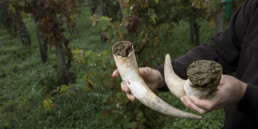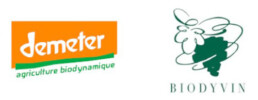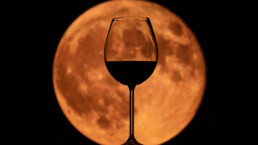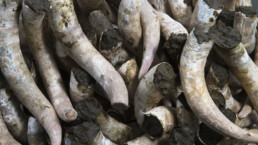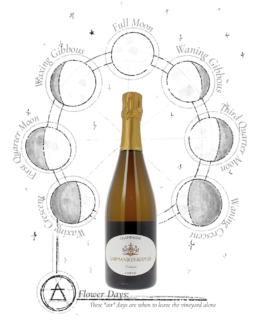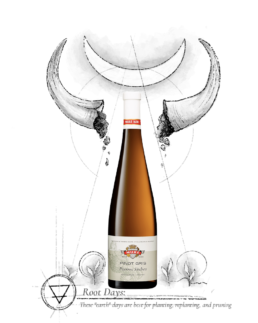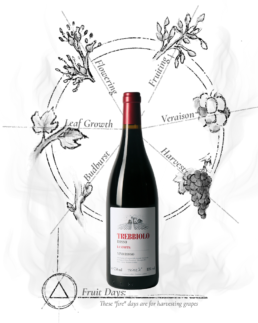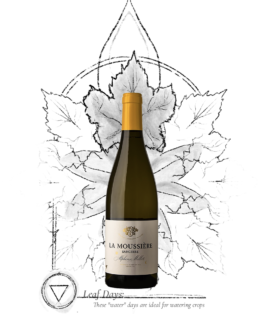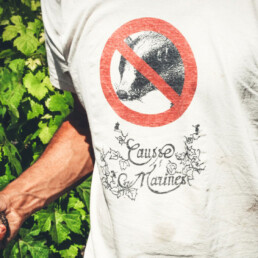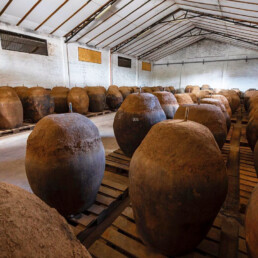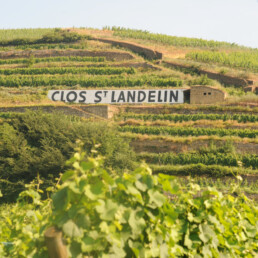Cow Horns, moon phases, sheep skulls, stag’s bladders, stinging nettles – stirred this way and that way. Is this wicked witchcraft or what happens when you put Harry Potter in charge of the winemaking? Think again, it’s time to Focus On unravelling the wonderful wacky world of Biodynamics.
As interest in natural, organic, sustainable, and chemical-free living continues to grow, it’s no surprise that wine is part of this global trend. While wine terms like “natural” and “organic” have been popular catch phrases in recent years, there’s one term that still eludes mainstream understanding: biodynamics.
You may have seen it on the occasional wine label or heard someone talking about it at a wine tasting, but chances are you’re still in the dark about what it means. Here we’ll try to decipher the basics of this esoteric-sounding wine philosophy and methodology as well as some nitty-gritty details that hopefully enlighten your next wine purchase.
Admittedly, biodynamics meets with a lot of criticism, largely because many of its most integral practices cannot be explained scientifically. Despite the criticisms though, biodynamics within the wine industry has grown significantly over the last few decades, with many big names adopting the unique philosophy. In NZ the demand for organic, biodynamic, and natural wines is growing rapidly, with organic grape production expanding from 600 hectares in 2008 to 2283 hectares last year, and has increased by 33 per cent since 2017, according to the latest organic market data from Organics Aotearoa. On the international stage, wine writer and biodynamic specialist Monty Waldin estimated that in 2018 almost 5% of all the world’s vineyards were certified either organic or biodynamic.
“Some wines tell us a story… From living soils and pest-resistant vines, to the warmth of the sun and cycles of the moon. Unadulterated aromas from winemakers who do not produce their wine but accompany it. These are wines from biodynamic cultivation. Wines with character.” – Biodynamic Certifier – Demeter International
Broadly speaking, biodynamics is a holistic, ecological, and ethical approach to farming, gardening, food, and nutrition. The task of nailing down a watertight definition of biodynamics is a fraught one though. While there are certain practices in common with organics, biodynamics takes the idea of organic farming to the next level. Now, let’s try to break down the basics behind the buzzword.
Who Was the 'Genius-Nutter' Behind Biodynamics?
In a nutshell, it was Austrian philosopher Rudolf Steiner who started the idea of biodynamics in the early 1920s, predating the organic movement by a long shot. This early 20th century spiritual philosopher and social reformer also promulgated the use of agricultural practices based on the lunar calendar and astrological influences, which today are the more controversial aspects of biodynamic farming.
Even back then, Steiner believed that the earth was out of balance due to the rapid industrialisation of farming, and that continued mass farming practices would deplete the earth’s ability to create healthy soil to yield healthy crops. His idea was that the land used for growing crops should be treated with preparations made from natural substances (manure, minerals, plants, and herbs) that are either buried or sprayed on the land. The goal was to enrich the soil during growing and composting to keep it healthy and not devoid of nutrients, as can happen in commercial farming.
Following the tenets of Steiner’s anthroposophy, biodynamic agriculture, including viticulture, viewed the farm and vineyard as a self-contained ecosystem (‘bio’, meaning life, and ‘dynamic’, meaning forces, energy) that can achieve both physical and spiritual harmony between the farmer, vine, soil, and yes, the cosmos!
“Farming biodynamically involves a changed philosophy or worldview, on which agricultural practice is then built. It’s largely caught, not taught.” – Dr. Jamie Goode, Wine Anorak
How Did Biodynamics Get Traction?
Between the two World Wars, there began a heavy reliance on ‘industrial intervention’ in farming practices to increase productivity. It was all about quantity not quality. Instead, over time this was killing the soils. Something had to change as was discovered in the late 80’s by French microbiologist Claude Bourguignon who had declared many of the famed Burgundy vineyard soils completely dead on a microbial level, due to decades of synthetic fertiliser, pesticide and herbicide usage. Meanwhile, the few biodynamic viticulturalists who did not use any of these, microbial life was thriving in their vineyards compared to the microbial deserts of their neighbours. He did not claim to have a scientific explanation, but the differences were clearly visible. This was a significant turning point for many disbelievers of the potential of biodynamic viticulture.
“Living wines need living soils. The soil is the “treasure chest” of every Demeter biodynamic vineyard.” – Demeter website
Who's in Charge?
For biodynamic certification, there are indeed very rigorous specifications to adhere to. The body that governs certification is Demeter International which was founded in Germany in 1928 right at the dawn of biodynamic agriculture and became the first eco-label for organically grown foods. There’s also France-based Biodyvin, which certifies over 160 European wineries – but it is not involved in food certification.
However, in February 2020, Demeter International and the International Biodynamic Association (IBDA) joined forces to form the Biodynamic Federation Demeter International. This new international umbrella organisation unites all Biodynamic and Demeter organisations worldwide. By the way, if you want to make sure your wine is biodynamic, it must have one of these certifications on the label:
One should keep in mind that the certification process for organic and biodynamic wines can be lengthy, costly, and complex. As a result, some wineries skip certification entirely but still claim to pursue biodynamic or organic growing and vinification processes. It’s always valuable to get the winery’s philosophy and back story from the restaurant Sommelier or trusted wine retailer.
“Demeter [biodynamic] vintners do not produce wine, they accompany it. In this way, the spectrum of aromas that stem from location and vintage, can unfold to develop its authentic character.” – Demeter website
The Hocus-Pocus of the Biodynamic Calendar:
Also known as the planting calendar, originally developed by Maria Thunn, this biodynamic calendar follows the moon phases through the zodiac to help winegrowers determine the best times for planting, watering, harvesting, and resting. Is that barmy? Not really, as it was something farmers have done for tens of millennia up until the agrochemical boom of the 1920s.
So, in the calendar, each day also coincides with one of the four elements of nature — earth, water, fire, and air.
Root Days: These “earth” days are best for planting, replanting, and pruning
Leaf Days: These “water” days are ideal for watering crops
Fruit Days: These “fire” days are for harvesting grapes
Flower Days: These “air” days are when to leave the vineyard alone
Curiously enough, the biodynamic lunar calendar isn’t just a guide for tending the vineyard – you can even use it to determine the best days for drinking wine! So, before opening that special bottle of vino, you might want to find out if you should wait for a full moon, crescent moon, or once in a blue moon. There are even different apps you can buy to track the cycles (e.g., ‘When Wine’ or ‘Bio Garden’).
So, What About Those Cow Horns in the Vineyard?
Though not necessarily appetising reading, let’s take a look at a few of the different techniques utilized in the biodynamic vineyard.
Biodynamic farming uses 9 preparations, numbered from 500-508 to prepare and fertilize the land used for farming. These are completely natural and rely on principles developed by Steiner to create balance between the physical and spiritual world.
They use two types of preparations: those for fertilizing and those for composting. They require combinations of natural substances (manure, herbs and flowers, minerals) and organic materials (cow horns, bladders, skulls) to be buried in the land or sprayed onto compost to help keep nutrients in the earth. Sprays are stirred (‘dynamized’) to create opposite vortexes (clockwise and counter-clockwise) to achieve balance. Here are a couple to show how it’s done:
Preparation 500 – Cow horns are stuffed with manure compost and buried into the ground all through the winter, then later excavated. Upon excavation, the stuffed material is spread throughout the vineyard. There is little information out there about why specifically a cow horn is used (never a bull’s horn), or why it’s buried in the soil. Preparation 500 is “essential”. “It is a powerful means for structuring the soil,” the Demeter site explains. It also “stimulates microbial activity of the soil”, regulates pH, stimulates seed germination, and dissolves minerals. Other compost preparations include yarrow, chamomile, and stinging nettles.
Function: Promotes root activity and stimulates microbiotic life in the soil.
Preparation 502 – Yarrow, a sweet-smelling, herbal plant, is sheathed inside a stag’s bladder, which is hung in the warm summer sun. It is buried throughout the winter and dug up the following spring. The bladder is then discarded, but its contents are used as compost.
Function: Helps control the breakdown of the manures and compost, helping to make trace elements more available to the plant. Important for reproduction and growth.
Preparation 505 – This one tops them all! The bark of an oak tree is grated into a powder in Autumn and placed into the skull of a sheep or cow. Don’t worry, it is essential that the skull is very clean. The skull is stored in a barrel filled with running water and rotted vegetation for a period of six months, during which time the oak bark goes through the process of fermentation. By the time this phase is complete, the skull will no longer be very “clean”. Also, unsurprisingly, it may smell a bit! Luckily, fourteen days of stirring the preparation will result in an inoffensive, sweet aroma.
Function: Works strongly with calcium, helps to combat plant diseases (especially fungus), and controls rampant growth.
The others are based variously on – quartz ground to a powder (501), chamomile (503), nettles (504), dandelion (506), valerian (507) and horsetail plant (508), with casuarina as the southern hemisphere alternative.
If you’re feeling skeptical (and queasy) at this point, you’re probably not alone. But before writing off biodynamics, keep reading – and then do some tasting!
Biodynamic Wine vs. Organic Wine:
“[in biodynamics there is] the emphasis on soil health, as in organics, which is surely sensible.” – Jancis Robinson, MW & wine critic
Both styles prevent the use of synthetic herbicide, fungicides, and pesticides in the vineyard. However, that’s where the similarities end. In organic wine production, there are a number of additives permitted, added sulphites and extra yeast compounds winemakers can use in the wine.
European regulations stipulate that organic dry red wine can have up to 100 milligrams of sulphites per litre and organic dry white or rosé wine can have up to 150 milligrams. Organic wine can also have extra yeast, sugar and tartaric acid added to it when fermenting, to help manipulate the outcome or taste profile of the wine. And there are some distinctions within organic wine labelling – those labelled “made with organic grapes” can include added sulphites but wines that are “certified organic” cannot.
Looking at this you might think we’re saying organic wine isn’t that great. Quite the contrary. Organic wine has considerably less preservatives and added extras than conventional wines.
Meanwhile, biodynamics is the agricultural system that’s effectively a supercharged version of organics, with some extra ‘stuff’ thrown in. It means that winemakers can’t add any synthetic agents in the grape growing process but also states that in the winemaking process, they can’t add foreign agents like extra yeast or acid. This ensures that the wine is a true representation of the vineyard. So, you could say, if a wine is biodynamic, it is organic; but if a wine is organic, it is not necessarily biodynamic.
Biodynamic Wine vs. Natural Wine:
When comparing biodynamic wine to natural wine, you can simply look at the label to determine if a wine is verified as biodynamic, but there is no such international certification for natural wine. In France in late 2020 they established an organisation called ‘Vin Méthode Nature’ to regulate the natural wineries.
Generally, the assertion is that “natural” indicates nothing artificial or synthetic has been added, but there is no legal definition for labelling the wine outside of France. It is the foundation tenet of natural wine that it is made with the bare minimum of intervention both in the field and in the cellar. Ideally, the grapes are organic (but not necessarily so) and hand-harvested, the wine is allowed to spontaneously ferment using indigenous yeasts, no sterile filtering or fining processes are used and only the tiniest amount of sulphur dioxide is occasionally added at bottling. It is quite a loose, unregulated set of guidelines for natural wines compared to biodynamic wines. As such, beware that winemakers are on an ‘honour system’ when it comes to labelling natural wine, so only buy brands you trust or have been recommended.
Does Biodynamic Wine Have Sulphites?
Just to be clear – wine without sulphites doesn’t exist since these compounds are a natural by-product of the fermentation process. The main concern is whether or not sulphites are naturally occurring or chemically created. Sulphites aren’t altogether bad. They can preserve a wine’s shelf life, colour, taste, and freshness. These compounds are measured in parts per million (ppm). Here’s the breakdown:
Conventional wine: Up to 350 ppm
“Made with organic grapes” wine: Up to 100 ppm
Biodynamic wine: Up to 100 ppm
Certified organic wine: Up to 10 ppm (in other words, only naturally occurring sulphites)
While there’s a common assumption that sulphites are to blame for everything from headaches to hangovers, studies show that tannins and level of alcohol are much more likely to cause unwanted reactions. And don’t forget that unlike organic or biodynamic producers, commercial winemakers use dozens of undisclosed ingredients that could cause side effects. Drinkers beware!
Are Biodynamic Wines or Wine Made With Biodynamic Grapes Vegan?
These wines are not vegan because they use organic materials derived from animals in the process of making them. If you eat a vegan diet rather than adhere to a vegan lifestyle, biodynamic wines would work for you since there are no animal products or derivatives in the wines themselves. But if you adhere to a completely vegan lifestyle (i.e., you do not wear leather, etc.) biodynamic wines are not considered vegan.
Is Biodynamic Wine Just Another Wellness Trend?
Some sceptics see the philosophical aspects (like utilizing the lunar cycle) as pseudo-science. Others see the buzzword as another wellness trend. “Whether you believe in the philosophy or not,” says Master of Wine Vanessa Conlin, “biodynamic farming shows a commitment from the grower, farmer, and vintner that they’re investing in their land in a way that’s respectful of nature and of everything around them.”
Although practicing sustainability is beneficial for the land and its surroundings, there isn’t a ton of hard data to prove that strict biodynamic farming is more beneficial than other types of sustainable farming, or that the wine itself is healthier for the drinker. But just being aware of where the wine you’re drinking comes from can be beneficial in many ways. Trying to avoid ingesting pesticides? Opt for a biodynamic wine. Looking to support a vineyard that practices ecological sustainability? Buying a biodynamic bottle is a great way to do that.
“I have often found extra vitality in wines that turned out to be biodynamic.” – Jancis Robinson MW
The Bottom Line – Will You Taste the Difference?
Yes and no! Though biodynamic winemakers seek to make vibrant, pure wines that are indicative of where they come from, there isn’t a specific tasting note that would indicate a wine is biodynamic or not.
Biodynamic farming doesn’t ensure that the finished wine will taste better or different, but you can make a presumption that if they’re spending that much time investing in their vineyard, then they care about what’s going into the bottle.
Many winemakers sincerely believe that biodynamics offers them an ability for a true and pure expression of grapes and ultimately the wine, and they can do so without relying on a variety of pesticides, fungicides, and herbicides etc. that can obscure the clarity of the product and where it’s coming from.
There are, however, many highly acclaimed biodynamic wineries throughout the world that add empirical evidence in favour of biodynamics, making a difference to the quality in the glass. As the old saying goes, the “proof of the pudding is in the eating”.
Worldwide there are over 700 biodynamic certified wineries. Wine geeks will instantly recognize the de la Romanée-Conti name since it is considered Burgundy’s most acclaimed and famous estate and it’s all biodynamically farmed! Other prestigious biodynamic estates are Domaine Leroy of Burgundy, Larmandier-Bernier in Champagne, Rhone’s Maison Chapoutier, first growth Château Latour, Château Palmer and Pontet-Canet of Bordeaux, Nicolas Joly of the Loire, Cullen, Henschke, Yangara in Australia, NZ’s Felton Road, Rippon, Quartz Reef, Seresin, Millton, Pyramid Valley and many more.
On the basis of the experience of those who have been practicing biodynamic viticulture over decades, all are convinced that vines find harmony and the ability to withstand disease and extreme weather which is highly advantageous in these times of climate change.
While biodynamic wine generally may not taste any different than other wines, some say that it offers the truest expression of terroir because of the extreme thoughtfulness and painstaking methods taken on the journey from grape to glass. So, give it a try. At the very least you’ll have a good story to tell.
In these times of drastic meteorological chaos and change, we all seek to be a little bit “greener”. We buy organic produce, shop with reusable bags, and recycle just a bit more than we used to. With sustainability and natural movements front and centre in our minds, the conscientious practices of biodynamic wine-growing seems to feel ‘right’ for many of us. Perhaps now more than ever, it could be timely to seek out those ‘wacky’ biodynamic wines and raise a toast to the moon, stars, and your Biodynamic Winemaker!
“Terroir is to wine what the score is to music.” – Pierre Larmandier, Champagne Larmandier-Bernier, Certified Biodynamic since 2004
Some of Our Dhall & Nash Biodynamic Wines:
NV Champagne Larmandier-Bernier Extra-Brut Blanc de Blancs ‘Latitude’:
“Based on the 2016 vintage and disgorged in December 2018, bursts with a generous bouquet of yellow orchard fruit, peach, blanched almonds and white flowers that’s less citrusy and stony than the corresponding Longitude. Full-bodied, broad and textural on the palate, it’s fleshy and enveloping, with ripe but racy acids and a muscular core of fruit, concluding with an expansive finish.” 91/100 points, Robert Parker’s Wine Advocate (Biodynamic)
2018 Domaine Rene Muré Pierres Sèches Pinot Gris:
“Pure and bold notes of freshly cut russet-pear peel fill the nose on this wine. The palate adds flowing pear juiciness and concentration. Bold fruitiness is held in check by pithy, not quite zesty freshness. This wine has drive and energy, with a just off-dry finish.” 91/100 points, Anne Krebiehl MW, Wine Enthusiast (Organic and Biodynamic)
2019 La Stoppa Trebbiolo Rosso:
Wild, earthy, yeastiness on the nose, incongruously like fresh vanilla pod with its earthy sweet-leathery notes. Aromas of small berries, blackberries, myrtle. Dryish on palate, which is meaty, earthy, spicy, sweet earth, lardo, and refreshing acidity. Youthful and purple and vibrant. Cries out for a big plate of charcuterie and cheese and some top class air-dried hams. Barbera 60% Bonarda 40%. (Organic certified & following some biodynamic practises)
2019 Alphonse Mellot Sancerre La Moussiere Blanc:
“Grown on the famed Kimmeridgian chalk of Sancerre, this wine is intense, tightly wound with young fruits and acidity. With its power, dense green-fruit flavours and steely edge, the wine is set for aging.” 93/100 points, Roger Voss, Wine Enthusiast (Organic and Biodynamic)
More of the wonderful biodynamic producers in our portfolio:
Causses Marines
Chateau Climens
Cristom
Domaine des Pothiers
Domaine Morey-Coffinet
Georges Laval
Grosset
Hyde de Villaine
For order please email us at orders@dnfinewine.com.
